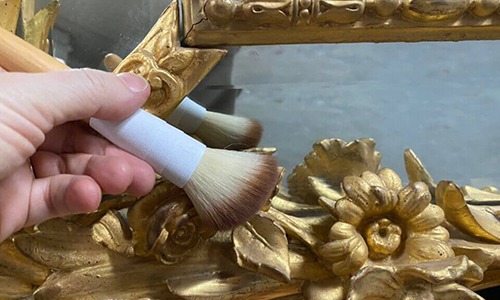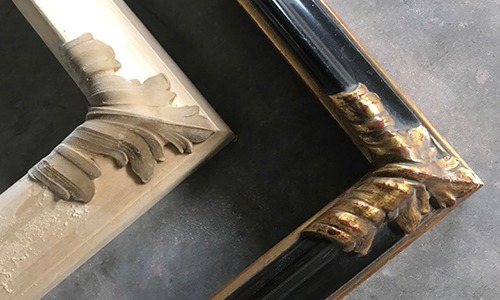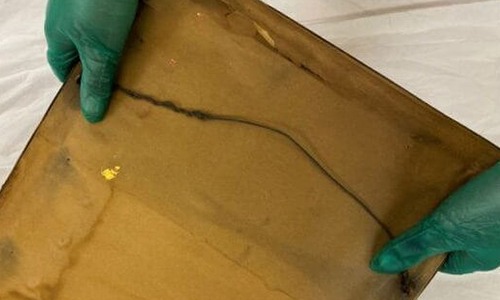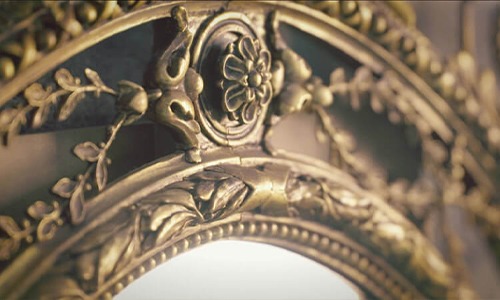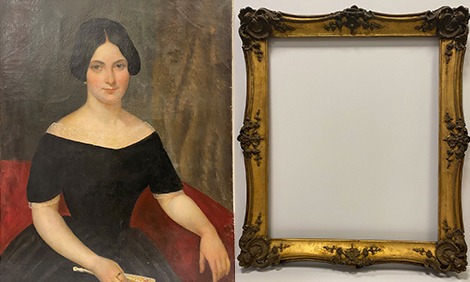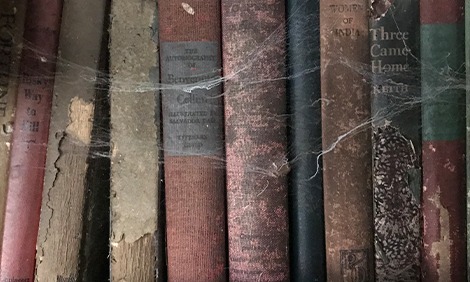8 Fundamental
Lessons for Archival Framing
8 Fundamental Lessons for Archival Framing
By April Hann Lanford
When you meet with a specialist about framing your work of art, selecting the right frame is only part of the equation. The proper frame should not only beautifully present the piece, but it should also protect it too. Over the years we have seen many pieces arrive in the studio needing conservation due to improper framing with non-archival materials.
8 Common Issues that Result from Non-Archival Framing
1-Regular Glass – Works framed over 30 years ago are frequently framed with non-UV protective glazing. While on display, the artwork in the frame is exposed to both sunlight and artificial light, both of with can cause fading and discoloration.
2-Acidic Matting – Acidic mats are made of paper-based support that darkens over time. The acids migrate into the artwork causing discoloration and embrittlement.
3-No Spacer or Mat – Matting not only serves as a decorative element but also provides space between the face of the artwork and the interior of the glazing. Artwork should never be in direct contact with glazing because the artwork can adhere to the glazing over time, resulting in disfiguring damage to the piece.
4-Improper Hinging – Adhesive from pressure-sensitive tapes can be difficult to remove, often causing discoloration and or skinning of the paper support. It is a common practice to tape the artwork directly to the back of a mat, however, that can lead to damage when handled in the future.
5-Cardboard – Often used as a backing material in the past, it is highly acidic. Like matting mentioned above, acids can migrate into the artwork and cause significant discoloration and embrittlement.
6-Inappropriate Size – Artwork is folded or trimmed to fit within an existing frame. This is not always readily evident when reviewing a piece firsthand in a frame. Original artwork and limited edition prints should never be altered to accommodate a frame.
7-Unstable Frame – The frame should be constructed to be able to support the size and the weight of the components it houses. Improperly designed frames can have rails that bow, and corners that open and are weak. This can not only cause damage to the artwork but also can lead to safety issues.
8-Loose Hardware – Hardware is one of the piece elements and is often one of the most overlooked. Small screw eyes are often too weak and can pull out. Improper installation of fasteners can cause splits in the frame, resulting in further instability, and damage.
The issues listed above were also in part can be attributed to the lack of availability of proper framing materials. Over the past 30 years, the quality and availability of archival framing materials have dramatically improved. Here are a few basics to remember for your next framing project.
8 Tried and True Archival Framing Recommendations
1-UV Filtering Glazing – Artwork should always be protected with UV filtering glass or acrylic. There are several options available that protect up to 99% UV. In addition to providing UV protection, there are also anti-reflective options that reduce and almost eliminate glare.
2-Rag Board Matting and Mount Boards – Rag boards are made of 100% cotton rag and do not acids from wood pulp that can deteriorate your artwork over time. Rag boards also come in a variety of tones and thicknesses, in the event that a neutral mat is something that you don’t have in mind. Artwork should always be hinged to a rag board mount, rather than to the mat.
4-Reversible Hinging – for archival mounting, reversibility is key. Photo corners allow for mounting without the use of adhesives. If photo corners are not a suitable solution, use ph-neutral adhesives such as methylcellulose or wheat paste with Asian paper for hinges.
6-Appropriate Size – Artwork should never be folded or trimmed to fit within a frame. Frames should also be built with an added allowance around the piece to accommodate the expansion and contraction of the sheet in the future.
8-Proper Hardware – Having the appropriate hardware installed on the back of the piece is imperative for the overall safety of the artwork, and frame.
A well-designed frame can serve two functions, to display a piece and with archival materials, it can help protect a piece too. Using these 8 basic guidelines is a good start for the archival frame design.
If you have any questions, please feel welcome to contact us at:
312-344-0331
April@artifactservices.com
Our collection of educational articles about
custom framing, collection care, and emergency response are updated regularly.
Click on each topic below for a menu of corresponding articles.
Collection Care Articles
By April Hann Lanford
Our collection of educational articles provides an introduction to many topics about the preservation and conservation of fine art, antiques, and fine furniture.
Topics are often written as a result of questions provided by our clients.
Emergency Care Articles
By April Hann Lanford
Our emergency care articles are a helpful introduction to how to prevent damage through preventative measures or art and antique collections. When a disaster strikes, prompt response and taking the right steps can mitigate further damage.
Antique Trader Articles
By April Hann Lanford
Visit our collection of articles that have been published in Antique Trader.
antiquetrader
For more than 60 years Antique Trader has been inspiring, informing, and entertaining the collecting community with timely...
Projects
By April Hann Lanford
A selection of Artifact’s most recent projects highlighting our conservation and preservation work. We present each unique story describing the conservation process from reviewing the history, cause of loss, and condition to the steps of the treatment.
Glossary
A collection of art and conservation terms along with makers and firms compiled into a glossary and highlighted throughout our website for reference.
We are available to assist you
Main Location
840 N. Milwaukee Ave, Chicago IL 60642
Mon-Fri: 9:00 am - 5:30 pm
Sat: 10:00 am-4:00 pm
Sun: Closed
Complimentary parking is available in the loading zone in front of the building
We can also serve you by appointment at our other locations in the Chicagoland area.
Additional Locations
Schiller Park • Highland Park • Lake Forest • Lincoln Park • Nashville, TN
Copyright 2024, Artifact Services, LLC | An Artmill Group Company
